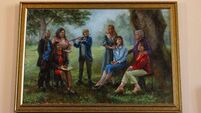Magpie or snag breac: What’s in a name?
It’s title was Zoilomastix and it appeared about 1625.
It interests me because it contains an extremely accurate description of the greater spotted woodpecker and states that this bird was common in the forests of Munster at the time.
Woodpeckers became extinct in Ireland shortly afterwards but O’Sullivan Beare’s description is one of a number of pieces of evidence pointing to the fact that they were once a relatively widespread breeding species. In recent years they have come back, re-colonising the country from a base in Co Wicklow.
O’Sullivan Beare wrote that the Irish language name for the bird was snagbruic or snagbreac. This is also interesting because it is the same as the modern Irish snag breac, which is the name for the magpie. At the time he was writing we believe there were no magpies in Ireland. The story is that the first small flock of magpies arrived in Co Wexford in 1676. What makes the story believable is that when magpie populations become over-crowded flocks of the birds have been observed flying out to sea, apparently prospecting for new territories. The assumption is just such a flock set off from south Wales in 1676 and arrived in Wexford.
Magpies and greater spotted woodpeckers are not related but there are some superficial similarities.
They are both strikingly pied birds of roughly the same size — though magpies are somewhat larger. So what seems to have happened is that when the woodpecker became extinct its name didn’t — it was transferred to the new arrival.
Something similar seems to have happened when the Eurasian crane became extinct as an Irish breeding species some time during the 1700s. The name, crane, is commonly used for the grey heron all over rural Ireland today. But the Golden Eagle Trust is researching a programme to re-introduce real cranes to Ireland. If this is successful it’s going to pose problems for those people who call herons “cranes”. It will be very interesting to see if the name transfer reverses itself.
Again, there is some superficial similarity between the two species although cranes are much larger than herons. The main reason they became extinct in Ireland was that they were a very popular food item. They also seem to have been quite popular as pets and there are several references to tame ones in the courts of Irish kings and chieftains.
They still turn up in Ireland fairly frequently. A couple of weeks ago almost 40 birds were spotted in two flocks, one in east Cork and one in west Cork, and another flock flew over the Rogerstown estuary in Co Dublin. They are migratory birds and sightings in the breeding season are very rare. But they do seem to be turning up more and more frequently. Just before the woodpeckers re-colonised this country without human help, there was a plan being prepared to re-introduce them. It’s not impossible the same thing could happen with the Eurasian crane.
Either way, if they do return they will provide an exciting spectacle for bird lovers. They are truly huge, standing shoulder height to a man. I’ve never seen one of these dances but the dry and sober Birds of Europe by Lars Jonsson says: “The birds leap up with raised wings, make deep bows, trumpet and erect the tail plumes.” I can’t wait.
* dick.warner@examiner.ie















